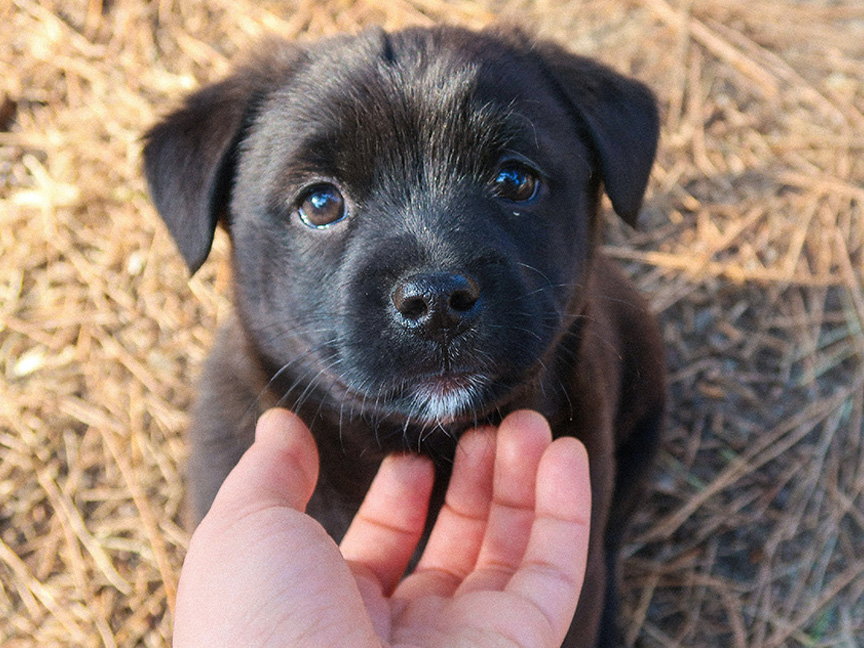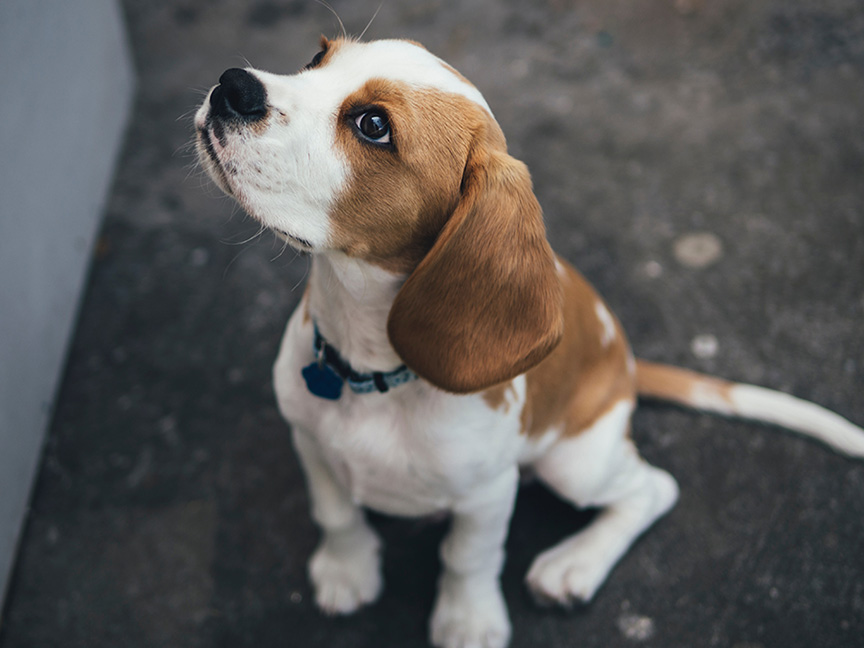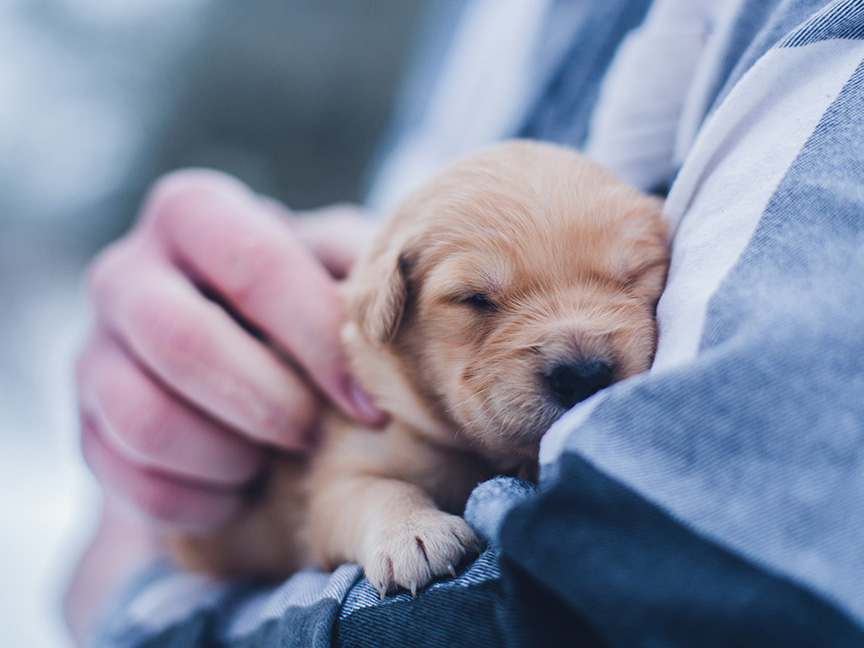Puppies & Play Biting Set Yourself Up for Success
Prepare yourself: if you are getting a puppy, initially you will be dealing with razor sharp puppy teeth nibbling on your arms and legs. Below are useful suggestions to teach your puppy that we are not other puppies and play biting is NOT our idea of fun!
5 KEY GUIDELINES
1. Set yourself up for success
Set yourself up for success by smart puppy management practices.
Minimize unwanted puppy/human interactions by putting pup in the crate or puppy safe area (playpen, gated off kitchen etc.), or tether him with the leash to a heavy piece of furniture when you are busy.
Only give your puppy freedom in the house when you have time to actively watch/engage him. At these times, focus on teaching him fun on our terms: structured play and training sessions. Or take him on a walk. After you are done playing, training, or walking, put him back in his puppy-safe place to hang out and to think of how much fun he just had with you! Do NOT wait to put him up until he starts misbehaving: first, this will make going to the crate/playpen seem like punishment; two, he already got to practice the unwanted behavior (and maybe found it fun!).
Puppy time, put up (rest or self-entertain) time, puppy time, put up (rest or self-entertain) time…such structure sets you up for success.
Giving your unattended puppy free rein of the house spells trouble–you will ignore him when he is good but give him attention (negative attention is still attention!) when he starts bugging you by jumping or biting or is otherwise naughty.
As discussed in the house-training handout, the crate is the best place for puppy to rest when you also want him to hold his pee or poop. A play pen or baby-gated area works well if your puppy just went to the bathroom and you know he is empty, but you don’t have time to engage him and you want him to play on his own.
Finally, tethering is a good practice to teach your puppy to settle down close to you even if not in a play pen (preparing for times when you no longer have a play pen.) For example, in the evening, when everyone is watching TV in the living room, you could tether your puppy to the back foot of the couch with a short leash–close enough to see him, reach over to pet him or treat him for settling, but not so close that he can jump on you, mouth you, or try to get on the furniture.
Even when your puppy is free, it can be very helpful to have him drag a lightweight leash that can give you more control. We call this a house line.
Ok, ok, you understand now that a lot of trouble can be avoided by limiting your pup’s options, but still… what should you do if your puppy DOES nip you?
2. Enforce consistent mini timeouts
Enforce consistent mini timeouts every time pup nips you. When your puppy nips you, first make a loud and somewhat startling “OUCH!!” or “Uh-Uh!” sound, then immediately follow up with a 30 second timeout. If a loud sound like that seems to just egg him on, use a more neutral verbal marker like “Done!” or “Time out!” Always use the same sound or word.
Note that this sound/word is likely not going to make him stop unless you consistently follow it up with a short time out!
Right after making the sound, have all fun come to a screeching halt. Don’t jerk your hand away, but withdraw it deliberately, then stand up, cross your arms and turn your head away (the head turn is what a higher-ranking dog does to an annoying puppy; they understand it!). Don’t move or talk for 30 seconds. Then ask pup to come, sit (make up) and resume normal activity. You could, at this point, direct puppy to playing with a toy, for example.
If standing calmly, with head turned away, does not make the biting stop (for example, if your puppy is playing tug of war with your pants or keeps biting you), you need to physically separate yourself. It works best if you can leave (close door, step out of playpen or over a baby gate etc.) Or you can use the house line (see above!) to keep the puppy away from you as you stand still.
Least ideal is to put your pooch in a time out spot, but if this is necessary, make sure that you can get him there in as easy, quick, and low-key way as possible. The house line is a great tool for this as well. You do NOT want any struggle, grabbing the puppy’s collar and still getting bit, as you would be creating more problems than solving.
The time out approach will work only if everyone is consistently doing the exact same thing. If your pup gets an interesting response for biting even every fourth or fifth time, he will not stop. Make sure all family members are on board and are consistent.
Do not get discouraged if you do not see immediate improvement!
Stick with this approach. It may take up to two weeks to start seeing results. The worst thing you can do is try timeouts for a couple of days, then do something completely different: you will be teaching your pup that biting results in unpredictable (interesting?) responses.
3. It’s fun to bite toys
Show pup what is tons of fun to bite (toys!) and what is zero fun to bite (you!)
If your puppy has an evening “witching hour,” this may be a sign of him being overtired. Make sure your puppy is getting enough rest–he is still a baby that needs naps! Build in down times into every day. Best is to put your puppy periodically in the crate for power naps even when you are at home. This will also help with house training and preventing separation anxiety.
Check the food you are feeding. Corn, wheat, soy should not be among the main ingredients. If there are such empty carbohydrates in your puppy’s food, he may be zooming around because he has a sugar high! A good quality food will result in more even energy, smaller and less smelly poops, and a healthier puppy overall, so do your research and choose well.
On the flip side, your puppy may need to play hard at times and have a legitimate outlet for even biting something. Teach your puppy how to tug with a special tug toy that only comes out when you play with him (that is, it does NOT live on the floor or in her toy basket). Have this toy tucked away in your pocket at all times. Direct him to this special tug toy whenever he looks like he is getting animated and wants to put his teeth on something.
Important clarification here: I do NOT want you to start playing tug of war with your puppy after he started chomping on you, lest he may learn that nipping you leads to an instant fun play session! Yes, I am officially telling you that the common advice to give your pup a toy RIGHT AFTER he started nipping you may actually reinforce the biting behavior. The correct response after a play bite is always a short timeout.
Final word on the evening witching hour: even if you don’t always follow the “active time” (a long walk, fetching or tugging, training) alternating with “put up time” (crate, play pen, tether) all day long, you may want to religiously stick to this schedule in the evening, so as to prevent the puppy crazies!
4. Be a loving, consistent leader
Be a loving, consistent leader; teach puppy that pushy behaviors don’t pay.
Initially, most puppies play bite, because they don’t yet understand that you are not another puppy and because they are getting some fun responses out of it. But if biting persists or gets worse over time, it’s often linked to a lack of respect for you.
There is a lot of confusion out there about “how to be alpha.” Even that expression implies that there is a power struggle. I prefer the term “leader.” Someone your puppy trusts, loves and looks up to for guidance. How do you become a leader? By being CONSISTENT, and, well, by leading. YOU decide when it’s playtime. YOU decide when it’s petting time. And so on. You set the agenda.
If your puppy is being pushy and demanding (barking at you, jumping at you, whining, dropping a toy on your lap, nudging you, pawing you), you must pretend he is thin air and IGNORE him altogether. Negative attention is still attention… A 90 degree head turn works wonders.
Incidentally, you can prevent the puppy from bugging you in the first place by having him put up when you are not interested in interacting with him. We keep coming back to smart management, don’t we?
Finally, don’t constantly fuss with your puppy. While you should definitely give him sufficient physical and mental outlets every day, you are not a 24/7 puppy entertainment unit. Teach him to entertain himself, settle down, and to be separated from you. Use those crates, playpens, and baby gates!
5. Teach & Supervise Children
If there are kids in the household, teach them good vs bad games with the puppy, and supervise all interactions.
Kids should be taught to freeze at the first sign of the puppy getting overly excited. Teach them to “stand like a tree:” feet not moving, arms crossed, head turned away from pup, and counting to 30 without moving a muscle. If this doesn’t work in calming down the puppy, they should shout out to YOU for help. If the puppy is dragging the house line, you can swoop in and separate them instantly. I also find that it is better not to allow pups on furniture in households with kids, so the children can use the furniture as a puppy-safe place.
There is a lot of confusion out there about “how to be alpha.” Even that expression implies that there is a power struggle. I prefer the term “leader.” Someone your puppy trusts, loves and looks up to for guidance. How do you become a leader? By being CONSISTENT, and, well, by leading. YOU decide when it’s playtime. YOU decide when it’s petting time. And so on. You set the agenda.
If your puppy is being pushy and demanding (barking at you, jumping at you, whining, dropping a toy on your lap, nudging you, pawing you), you must pretend he is thin air and IGNORE him altogether. Negative attention is still attention… A 90 degree head turn works wonders.
Incidentally, you can prevent the puppy from bugging you in the first place by having him put up when you are not interested in interacting with him. We keep coming back to smart management, don’t we?
Finally, don’t constantly fuss with your puppy. While you should definitely give him sufficient physical and mental outlets every day, you are not a 24/7 puppy entertainment unit. Teach him to entertain himself, settle down, and to be separated from you. Use those crates, playpens, and baby gates!
GOOD LUCK!!!
If, after trying all the methods above for a couple of weeks, play biting is NOT diminishing, and even worsening, you should most definitely consult a positive dog trainer. Those little puppy teeth may be needle sharp, but the adult teeth can do much, much more damage… so this needs to be fixed before your puppy turns five or six months old!!!

Before You Adopt
Thinking of adopting a puppy? Start here to learn more and see if you are ready!

Getting Settled
Behavior, training, and health resources to help you support your puppy!

Best Paw Forward
The first few months of life offer an almost magical ability to shape a puppy’s future!